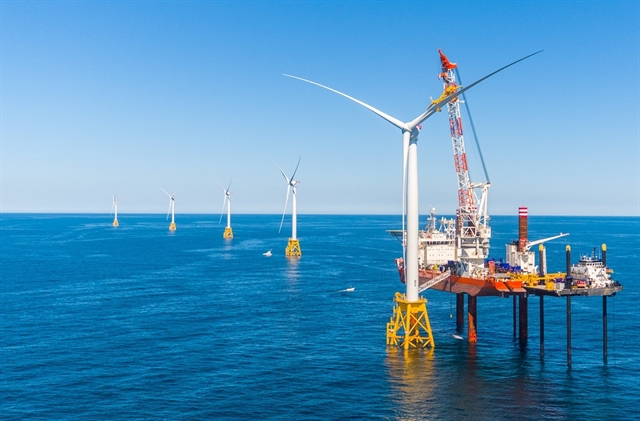While Vietnam possesses great offshore wind energy potential, the lack of a legal framework has impeded development.

An offshore wind power farm under construction. — Photo courtesy of Petrovietnam
The absence of plans for electricity export and the necessity to resolve regulatory issues underscore challenges in advancing offshore wind energy in Việt Nam.
The sole offshore wind project authorised by the Prime Minister for survey and pre-feasibility study is a collaboration between PetroVietnam Technical Services Corporation (PTSC) and its Singaporean counterpart Sembcorp Utilities Pte Ltd.
Given the constraints on renewable energy sources, the Energy Market Authority of Singapore (EMA) has approved importing 4GW of clean electricity by 2025 from neighbouring countries, including 1.2GW from Việt Nam.
Sembcorp will import this clean electricity from Việt Nam to Singapore, generated from offshore wind farms in collaboration with PTSC and transmitted through new underwater cables spanning about 1,000km.
Following full approval from the Ministry of Natural Resources and Environment of Việt Nam for marine resource surveys and assessments in August 2023, PTSC is set to conduct offshore surveys in 2024 for its project aimed at exporting clean electricity to Singapore.
In March, a Singaporean government delegation visited PTSC's facilities to witness the advanced infrastructure invested by PTSC in global offshore renewable energy projects.
The Singaporean authorities pledged continued support to PTSC, reinforcing bilateral ties and mutual goals, including Singapore's emissions targets and economic partnerships with Việt Nam.
This strengthened Singapore's trust in Việt Nam as the key partner for importing 4GW of clean electricity by 2030. PTSC and Sembcorp are progressing with the necessary approvals and activities for the successful implementation of the project.
Prior to its involvement in the offshore wind farm project for exporting electricity to Singapore, PTSC stood out as the only Vietnamese firm to win international bids for erecting offshore wind turbine foundations and transformer stations for foreign investors.
Over the years, PTSC has successfully exported numerous foundations and mechanical components to Taiwan (China) and various northern European countries.
"Offshore wind power is a key focus in the corporation's strategic realignment," Lê Mạnh Hùng, chairman of Petrovietnam, told baodautu.vn.
"Petrovietnam is developing a portfolio of offshore wind energy projects, seeking approvals, training its workforce, partnering with major global firms, investing directly, engaging in global offshore wind energy supply chains and working towards self-reliance in offshore wind power development."
While Việt Nam possesses great offshore wind energy potential, the lack of a legal framework has impeded its development.
"Under the National Power Development Plan VIII, the target capacity for wind power is set to reach 6,000MW by 2030 and aims for between 70,000 and 91,000MW by 2050," Nguyễn Quốc Thập, chairman of Việt Nam Petroleum Association (VNPA), said in a statement.
However, challenges persist in approving the direction and selecting investors in the wind power sector due to inconsistencies among current legal management documents, according to Thập.
The laws on bidding, investment and locations lack clear definitions regarding the approval authority for wind power projects at different levels.
Guidelines for investigations, surveys, exploration and sea area allocation for wind power investments lack specific procedures in legal documents. Additionally, a pricing policy framework and mechanisms for wind power are absent, while the investment conditions for foreign investors in wind power projects remain unclear.
Proposed solutions
The Ministry of Industry and Trade has recently proposed a pilot project to explore offshore wind power for domestic electricity needs, omitting mention of projects for electricity export.
Even for meeting domestic demand, the ministry has identified regulatory issues that need addressing to advance this energy source.
To address this, Lê Mạnh Cường, general director of PTSC, proposed that, prior to establishing long-term policy mechanisms, the Government should enable Petrovietnam, PTSC and other capable enterprises to implement offshore wind projects through pilot programmes and tailored policies.
Domestic enterprises, state-owned corporations and groups should be prioritised for involvement in this sector, Cường said.
VNPA chairman Thập also proposed six solution groups for the development of LNG and offshore wind projects.
The first group focuses on legal frameworks and policy mechanisms. He suggested the need for coherent amendments and additions to relevant laws.
Meanwhile, boosting research on electricity market development closely aligned with the objectives of Power Development Plan VIII.
The third group addresses management mechanisms and enforcement. Thập highlighted the importance of revising the operational statutes and financial regulations of state-owned economic entities in the energy sector, like Petrovietnam, Vietnam Electricity (EVN) and Vietnam National Coal and Mineral Industries Group (TKV).
The three other groups emphasise the need for consultation and learning from experiences, shifting perspectives and attitudes towards LNG and offshore wind power and innovative solutions. VNS
Read original article here